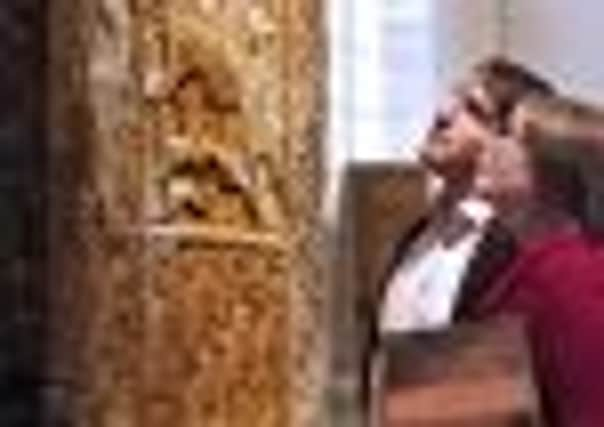Stone detectives discover one of Scotland’s earliest surviving depictions of Jesus in Hilton of Cadboll Stone


For more than a thousand years, the aristocratic rider carved on the 8th century Hilton of Cadboll Stone, discovered in Easter Ross, was assumed to be a Pictish princess out with a hunting party chasing a deer.
But a new book to be launched on Wednesday says that the long-haired figure riding side-saddle and wearing flowing robes is of Christ riding into Jerusalem in the days leading up to the Crucifixion.
Advertisement
Hide AdMartin Goldberg, one of the authors of Early Medieval Scotland: Individuals, Communities and Ideas, said he hoped his work would help kickstart a re-evaluation of the era known as the Dark Ages because of the lack of surviving written sources and show it as a time of intellectual vigour in Scotland with ideas flowing freely back and forth from mainland Europe.


Goldberg, the curator of Early Historic and Viking Collections at National Museums Scotland, described how he began his quest to discover the identity of the figure four years ago after glancing at the 2.5-metre tall sandstone cross-slab, a centrepiece of the museum’s Early People’s Gallery, and suddenly thinking: “You know, it doesn’t have to be a lady on that horse.”
The stone, which has a Christian cross on its reverse side, dates from around 800AD and is regarded as one of the finest 8th-century sculptures in Western Europe. It was carved following the conversion of the Picts to Christianity, celebrating their new religion.
Such Pictish carvings often showed hunting scenes because they represented an everyday activity which people would recognise. The evidence for the figure being female previously centred on the Pictish symbols of a mirror and comb also carved on the slab.
However, experts say only a select, educated few would have been able to interpret deeper significant “hidden”, and now thought to be Christian, messages, which were lost over time.
Goldberg said: “People have assumed the figure was female because it was riding side-saddle and we are used to the prim and proper Victorian image of women like that and of pictures of top-level aristocracy out hunting.
Advertisement
Hide Ad“But then I started to really think about it and I began to see that perhaps the two trumpeters behind the main riders on the stone had nothing to do with hunting and instead looked like they were performing a fanfare for an adventus ceremony welcoming a new king which would tie in with Jesus’s entrance into Jerusalem. It’s all very well coming up with an idea like that but then someone says ‘prove it’ and that’s the difficult part.”
Goldberg carried out extensive research across museums worldwide looking at carvings from the same era of Jesus on horseback, searching for similarities with the Hilton of Cadboll Stone. “I started examining other hunting scenes with riders and found a few of Jesus riding side-saddle. In particular, I studied one in the Coptic Museum in Cairo which was taken from Al-muallaqa church and shows a carving on a wooden lintel which is very similar to the Hilton of Cadboll stone with Jesus with long-flowing robes, long hair and riding side-saddle and entering Jerusalem.
Advertisement
Hide Ad“Jesus riding side-saddle can be ‘read’ as him sending a very personal message and wanting to appear humble, not a triumphant leader.”
Goldberg, whose findings were then peer reviewed by other experts, added: “All the elements started to tie in together.” The Hilton of Cadboll Stone stood on a chapel site in Tain, Ross-shire. Over the years, it was defaced, used as a gravestone and moved to Invergordon Castle before being donated to the British Museum. After protests, it was returned to the National Museum of Scotland in 1921.
The Glenmorangie Company, whose distillery lies near the chapel site, has funded a research project on Early Historic Scotland, of which Goldberg’s book is part.
Hamish Torrie, brands director of the whisky company, which uses a design from the lower half of the stone as the logo for its single malts, said the book was the latest in a line of “fantastic reveals” produced by the research team.
“When we started the project we didn’t want to see just a ‘signed off’ name plaque on a wall, we wanted to be actively involved and we are very proud to be associated with this work. When we did our re-branding, we went back to our roots and the Hilton of Cadboll Stone is a marvellous icon to work with. Today it’s on millions of bottles around the world and, by this, we’ve introduced the history of the stone to so many people.”
Hidden symbolism features elsewhere in the book with Alice Blackwell, the Glenmorangie research officer, revealing her finding that the elaborate engraving on some brooches from Early Medieval Scotland were meant to be “read” upside down by the wearer looking down at Christian symbols.